How to grow amazing bananas
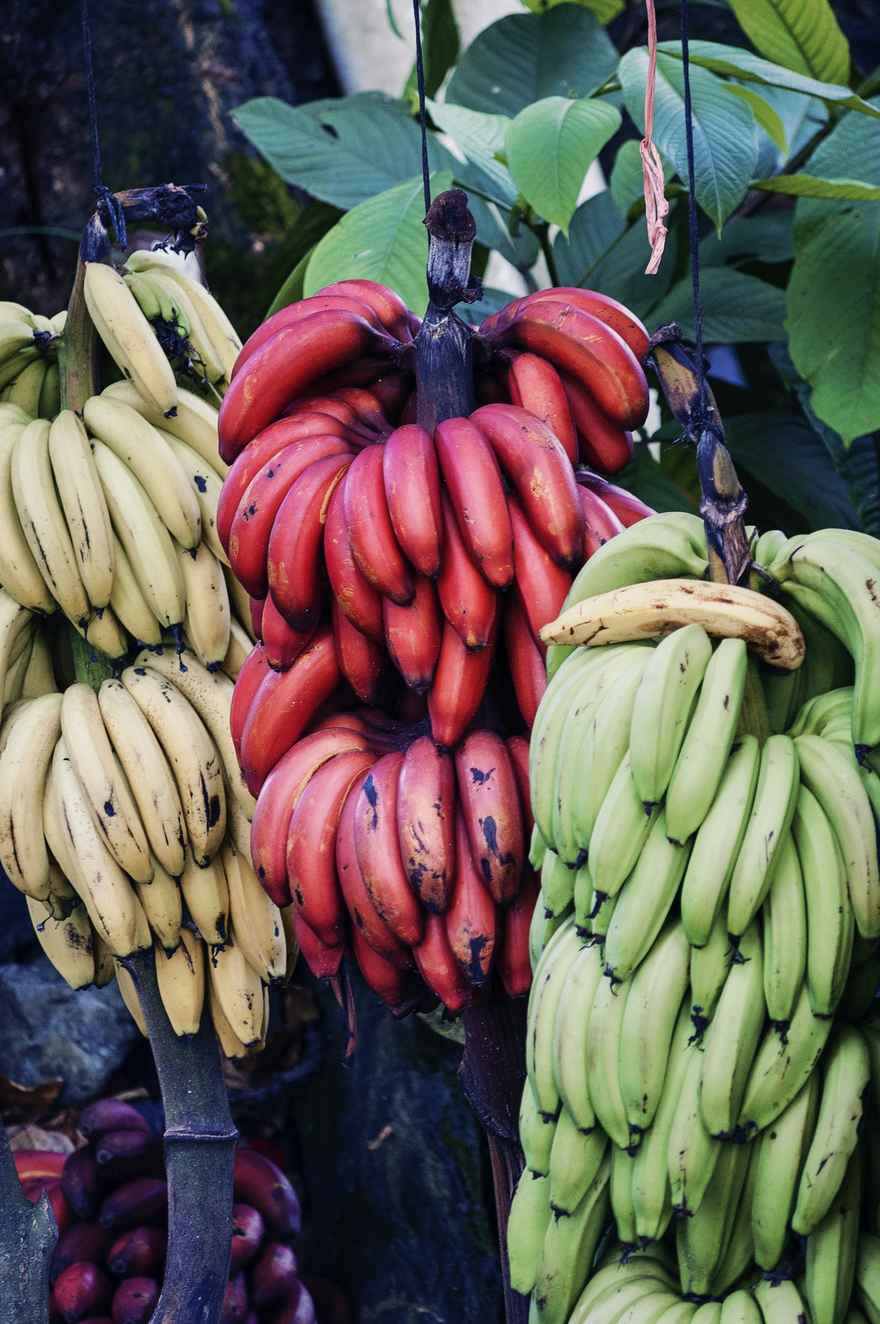
How to grow amazing bananas
In this article
- Introduction: Interesting facts
- Sun/Water/fertility/soil requirements:
- Planting
- Propagation
- Maintenance
- Harvesting
- Pest and diseases:
- Permaculture design functions of bananas:
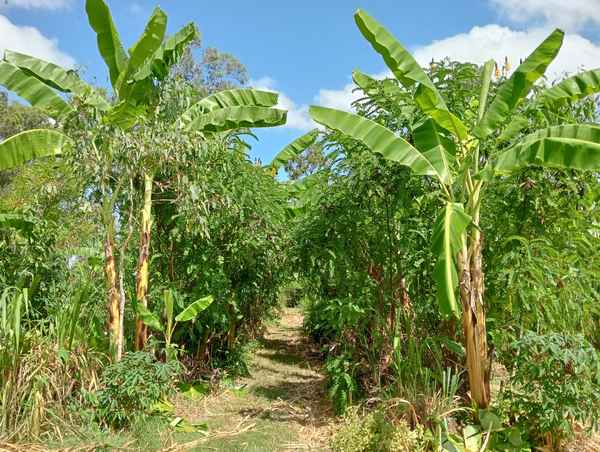
Bananas in syntropic system Bananas interplanted between fruit trees at Bloomfield’s Homestead.
Banana Plant Fun Facts
Largest Herbaceous Plant: The banana plant (Musa spp.) holds the title for being the world’s largest herbaceous plant. While it may appear like a tree, it is technically an herb because it lacks woody tissue.
Multiple Species: There are over 1,000 different varieties of bananas, but most of them belong to two species: Musa acuminata and Musa balbisiana. These species have given rise to numerous cultivated varieties.
Fast Growth: Banana plants are known for their rapid growth. Under ideal conditions, they can grow up to 10 feet (3 meters) in a single year.
False Stem: The trunk-like structure of a banana plant is not a true stem but rather a tightly coiled arrangement of leaf sheaths. This pseudostem provides support for the plant and can reach a height of 6 to 9 meters.
Leaves and Fruits: Banana plants have large, elongated leaves that can grow up to 9 feet (2.7 meters) in length and 2 feet (0.6 meters) in width. The leaves are often used for cooking, serving, and wrapping food in some cultures. The banana fruit grows in clusters called hands, with each hand typically containing 10 to 20 individual bananas.
Unique Flowering: Banana plants produce one inflorescence (a cluster of flowers) per pseudostem. The inflorescence emerges as a large, cone-shaped structure called the banana heart. Each flower on the inflorescence eventually develops into a banana fruit.
Genetic Diversity: The genetic diversity of wild bananas is significantly greater than that of cultivated varieties. Wild bananas can contain seeds, unlike most cultivated bananas, which are seedless and propagated through vegetative means such as suckers or tissue culture.
Nutritional Value: Bananas are a nutritious fruit. They are a good source of dietary fiber, potassium, vitamin C, and vitamin B6. They are also low in calories and fat, making them a popular and healthy snack.
Climacteric Fruit: Bananas are climacteric fruits, which means they continue to ripen after they are harvested. This is why bananas are often picked when they are still green and firm, allowing them to ripen gradually during transportation and storage.
Economic Importance: Bananas are one of the most important fruit crops worldwide, both in terms of production and consumption. They are grown in over 150 countries, with the largest producers being India, China, the Philippines, and Ecuador. Bananas are a staple food for millions of people and a significant export commodity.
Sun
Bananas are tropical plants that require a significant amount of sunlight to grow and thrive. While they can tolerate partial shade, they generally require a minimum of 6 to 8 hours of direct sunlight per day to produce healthy fruit. However, it’s worth noting that the specific sunlight requirements may vary slightly depending on the banana cultivar and the climate conditions in which they are grown.
Fertility
3 litres of poultry manure every 6 weeks – except during winter and cover the manure with compost to stop it being washed away by heavy rain.
Water
Bananas are one of the most water thirstiest plants. For fast fruit production and establishing a healthy plant water:
- 60l /week in summer
- 20l/week in winter
- Grey water is great
- The healthier your soil is, the less watering is required.
Best soil for growing bananas
Bananas thrive in a variety of soil types, but they prefer well-draining soils that are rich in organic matter. Here are some characteristics of the best soil for growing bananas:
Loamy Soil: Bananas prefer loamy soil, which is a balance of sand, silt, and clay. Loam provides good drainage while retaining moisture and nutrients.
pH Level: The ideal soil pH range for bananas is between 5.5 and 7.0. Slightly acidic to neutral soil pH is preferable for optimal growth and nutrient uptake.
Organic Matter: Bananas benefit from soils with high organic matter content. Organic matter improves soil structure, nutrient availability, and moisture retention. You can incorporate well-rotted compost, aged manure, or other organic materials into the soil before planting.
Drainage: Adequate drainage is crucial for banana plants. Excess waterlogged soil can lead to root rot and other diseases. Ensure that the soil is well-draining to prevent water accumulation around the roots.
Moisture Retention: While drainage is important, it’s also essential to ensure that the soil retains some moisture. Mulching around the base of the banana plants helps to conserve moisture and regulate soil temperature.
Propagation
Propagation from suckers, harvest a strong and healthy sword sucker with a minimum stem thickness of 10cm, 15 – 20cm is better and minimum of 1.2m tall, best is 1.5 – 2m tall. Watch the video we made on how we select and harvest banana suckers. Just note that some people don't believe that it makes a difference using sword suckers for propagation. This is what we do here at the homestead and it has been working well.
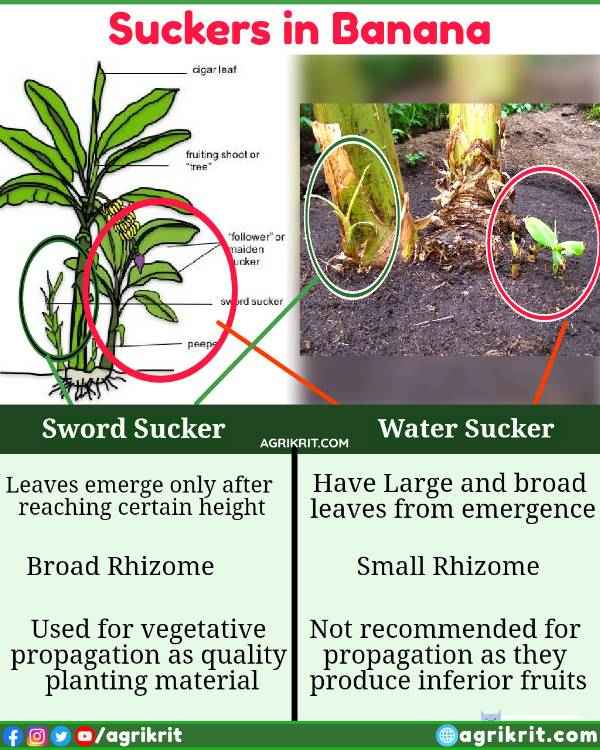
Planting
Dig hole 30 to 50cm deep, bananas are shallow rooted, therefore don’t have to dig too deep.
Width of the hole should be 50 to 80cm wide. Amend the soil with good quality compost and aged manure or 2 big hand scoops of pelletised poultry manure.
Plant the sucker 10cm deeper than the previous soil level. This promotes a stronger plant.
Form a watering ring with the dug out soil and water in with a watering can of soil conditioner such as a seaweed solution.
Maintenance
Regularly ‘chop and drop’ old leaves off. The plant only needs 5 solar panels. This allows airflow and reduces fungal diseases and pests.
Only leave up to 3 suckers growing from the main mother plant. We often only let one emerge from the mother plant in our syntropic food forest rows, where the bananas are grown as a filler plant in-between fruit trees.
Cut the bell (flower) off once the last fruiting hand has formed. This will promote bigger fruit.
After the bell has been removed, a bag can be placed over the ripening fruit to protect it from birds and possums. If there is an issue with these in your garden.
Harvesting
Time after flowering: Depending on the variety, bananas usually take around 60 to 150 days to ripen after flowering. Keep track of the time since the last flowering, as it can give you an indication of when they might be ready for harvest.
Visual check: The fruit is ready for harvesting when the top row of banana hands turn slightly yellow. The rest of the bunch is still green.
You can harvest the whole bunch at once and let it ripen in storage or you can harvest single hands of bananas at a time. This prolongs the ripening phase.
Pest and diseases
Banana weevils are destructive insects that infest banana plants, causing damage to their roots and pseudostems. The term “banana weevil” typically refers to a group of insects that are pests to banana plants. These weevils belong to the family Curculionidae and are known for their destructive impact on banana crops. They primarily attack the roots and pseudostems of banana plants, causing damage to the plant’s structural integrity and nutrient absorption capabilities.
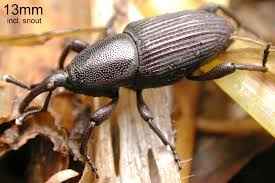
Banana weevil Source Lucid Apps
They have elongated bodies with a snout-like projection called a rostrum. The larvae reside within the plant tissues and feed on them, weakening the plant and reducing its yield. Control measures involve removing infested plants and using chemical treatments.
The larvae of banana weevils usually reside within the roots or pseudostems of banana plants, where they feed on plant tissues and cause further damage. This feeding activity weakens the plant and can lead to stunted growth, reduced yield, and even plant death if left uncontrolled.
There are two primary diseases that affect banana plants. The first is Panama Disease, which is caused by a soil-borne fungus. It is crucial to avoid moving banana plants to prevent the spread of this disease.
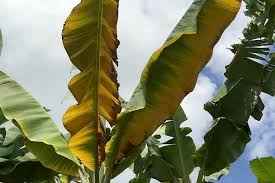
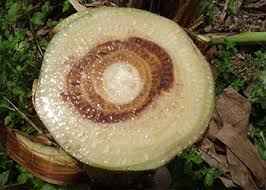
Panama Disease Source Department of Agriculture and Fisheries
Even soil on shoes and tires can transport the Panama Disease fungus, making it difficult to control.
The second major disease is Bunchy Top Disease, which is caused by a virus transmitted by the banana aphid.
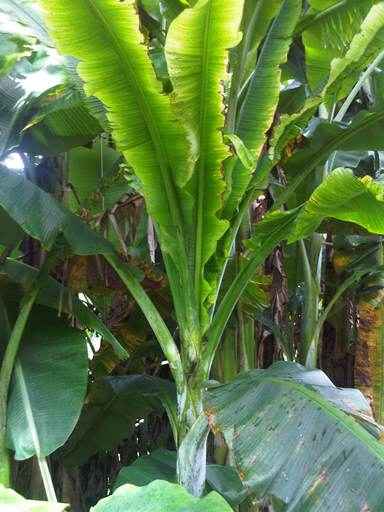
Banana Bunchytop Source DPI NSW
This disease significantly hampers plant growth and inhibits fruit production. Bunchy top disease is characterized by distinct symptoms. The new leaves become shorter, narrower, and more upright. When held up to the sun, these leaves show noticeable dark dot-dash lines that intersect with the midrib. Additionally, dark green stripes may appear along the midrib.
While controlling Panama Disease is challenging due to its soil-borne nature, measures can be taken to manage Bunchy Top Disease.
Permaculture design functions of bananas:
- Biomass production
- Grey water filtration
- Food forest filler plant
- Fibre production
- Soil stabilisers
- Food
- Fertiliser – soak banana peels in water
If you prefer a more hands-on learning experience or like to go deeper on the topic, consider a mentoring session with Doreen Jachmann, a permaculture and horticulture consultant. Alternatively, you can attend one of the monthly workshops at Bloomfield’s Homestead, which cover various self-sufficiency and food gardening topics.
Any questions or feedback, we love to hear from you.

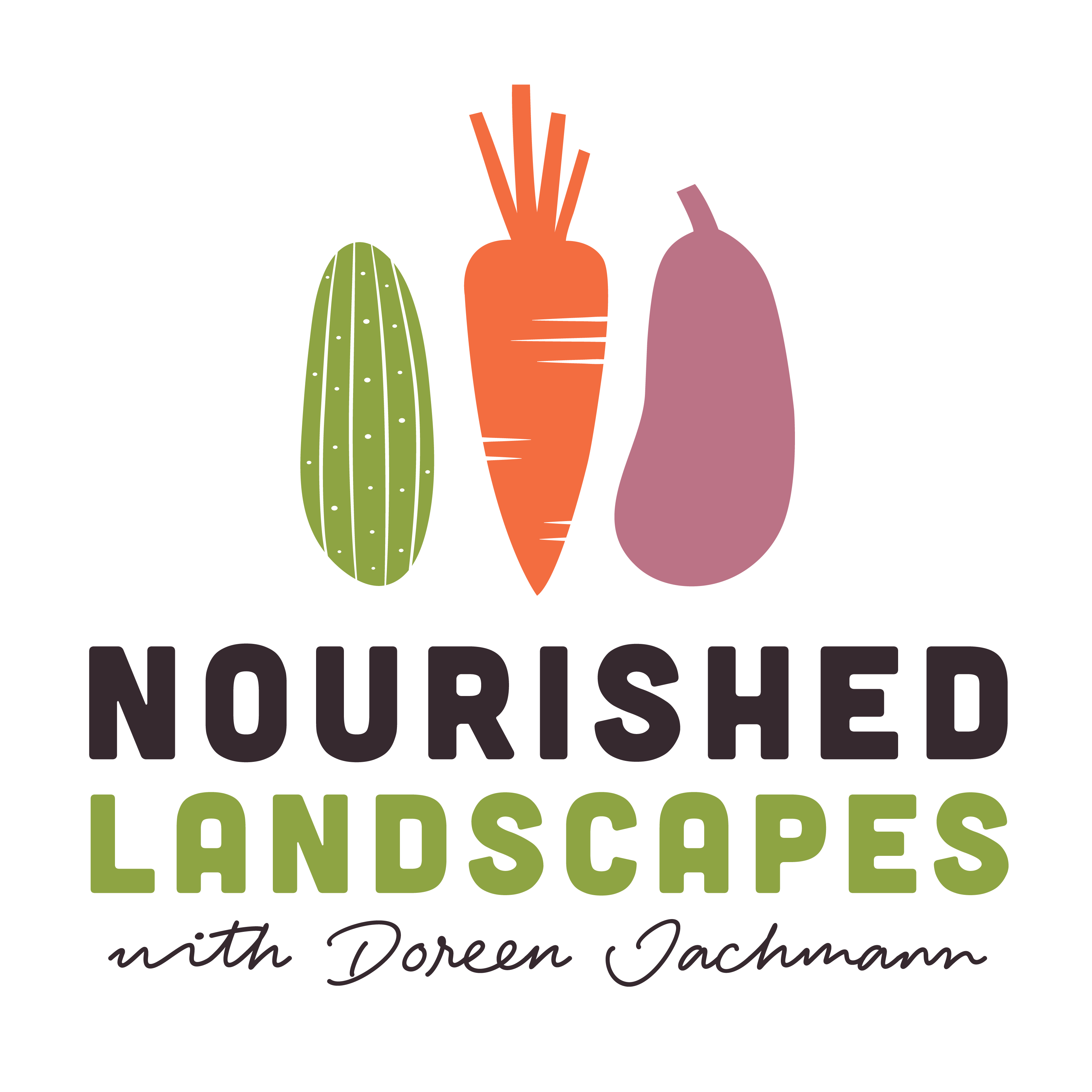
0 comments
Leave a comment
Please log in or register to post a comment